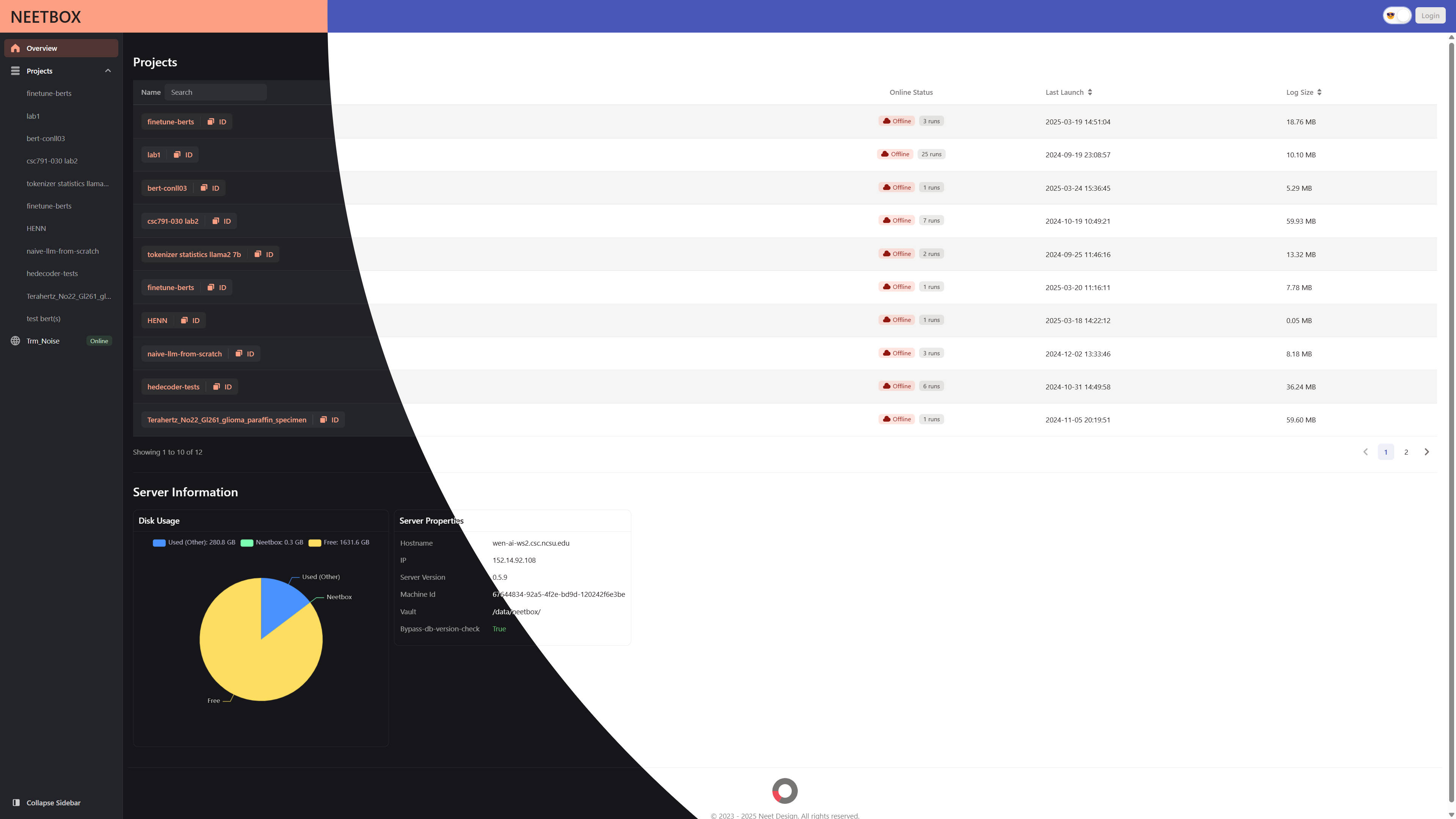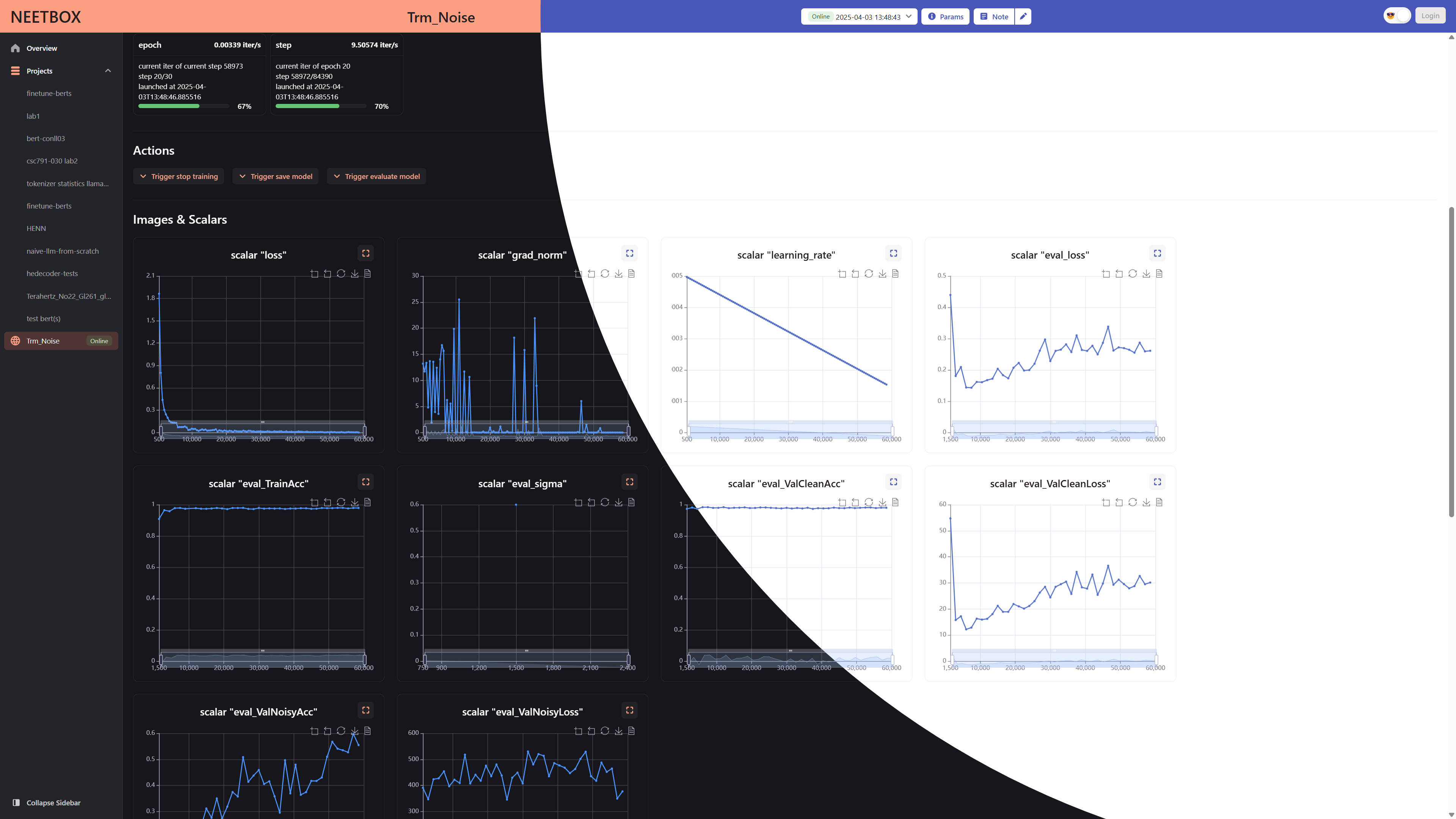Get started with an example
Installation
pip install neetbox
Use neetbox in a project
create a new project folder (or you can use existing folder as well)
mkdir newProject
cd newProject
edit test.py:
import math
import os
import time
from random import random
from time import sleep
import numpy as np
from PIL import Image
import neetbox
from neetbox import logger
@neetbox.action(name="action-1")
def print_text_to_console(text: str):
"""take action 1
Args:
text (string): print this string to console as log
"""
logger.log(f"action 1 triggered. text = {text}")
@neetbox.action()
def action_bool(enable: bool):
logger.info(f"action_bool triggered. enable = {enable}")
return {"enable": enable}
def def_plus_1(val):
@neetbox.action(name="plus1", description=f"val={val}")
def plus_1():
def_plus_1(val + 1)
def_plus_1(0)
@neetbox.action(name="wait-for-sec", blocking=False)
def wait_for_sec(sec):
sec = int(sec)
logger.log(f"wait for {sec} sec.")
time.sleep(sec)
@neetbox.action(name="block-for-sec", blocking=True)
def block_for_sec(sec):
sec = int(sec)
logger.log(f"block for {sec} sec.")
time.sleep(sec)
@neetbox.action(name="eval")
def eval_code(code: str):
logger.log(f"running code {code}")
logger.info("eval result: ", eval(code))
_id_indexer = 0
@neetbox.action()
def new_action(id: int):
global _id_indexer
@neetbox.action(name=f"empty_action_{_id_indexer}")
def action_():
"""this action does nothing"""
pass
_id_indexer += 1
@neetbox.action(name="shutdown", description="shutdown your process", blocking=True)
def sys_exit():
logger.log("shutdown received, shutting down immediately.")
os._exit(0)
@neetbox.action(name="Generate random noise image")
def send_image(width=400, height=300, num_channels=3):
"""Send a random noise image from numpy.array.
If nc is 1, the Grayscale image will be created.
If nc is 3, the RGB image will be generated.
Args:
nc (int): (1 or 3) number of channels.
width (int): width of output image.
height (int): height of output image.
"""
img = (np.random.rand(height, width, num_channels) * 255).astype(np.uint8)
if num_channels == 3:
img = Image.fromarray(img, mode="RGB")
elif num_channels == 1:
img = Image.fromarray(np.squeeze(img), mode="L")
else:
raise ValueError(f"Input nc should be 1/3. Got {num_channels}.")
neetbox.add_image(name="random noise", image=img)
@logger.mention()
def test_mention(text: str):
return text
@neetbox.action()
def run_test_mention(text: str):
test_mention(text)
@neetbox.watch("train")
def train(step):
loss, acc = random(), random()
neetbox.add_scalar("sin", step, math.sin(step * 0.1))
neetbox.add_scalar("cos", step, math.cos(step * 0.1))
return {"global_step": step, "loss": loss, "acc": acc}
@neetbox.listen("train") # listen to train
def print_to_console(metrix):
logger.log(f"metrix from train: {metrix}")
@neetbox.watch("log-some-prefix", initiative=False, interval=5.0) # run each 5 secs
def log_with_some_prefix():
logger.ok("some ok")
logger.info("some info")
logger.debug("some debug")
logger.warn("some warn")
logger.err("some error")
train_config = {"epoch": 50, "batch_size": 10}
def simulate_train(config):
epoch = config["epoch"]
batch_size = config["batch_size"]
with neetbox.progress(epoch) as e:
for i in e:
for j in neetbox.progress(batch_size):
time.sleep(1)
train(i * batch_size + j)
if __name__ == "__main__":
neetbox.add_hyperparams(train_config)
simulate_train(train_config)
Run your project
python test.py
visit http://localhost:20202/ and see the dashboard.
NEETBOX screenshot:


Features
You can:
- view remote logging
- send images or tensors as images to frontend
- send scalars to show a line chart
- check hardware usage
- register python functions as buttons and run remote python codes in dashboard
- manage projects and runs, as well as check history runs